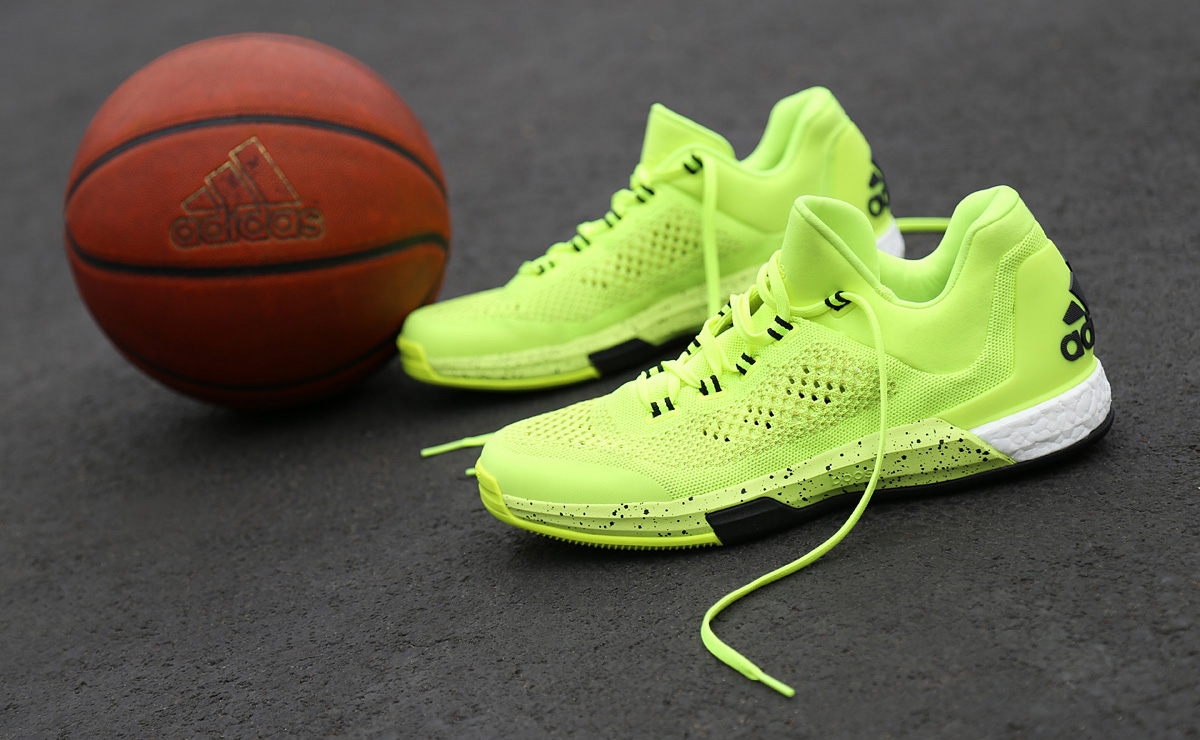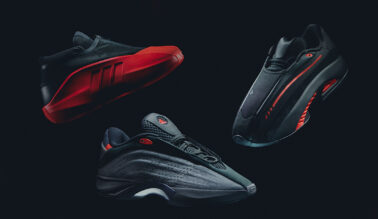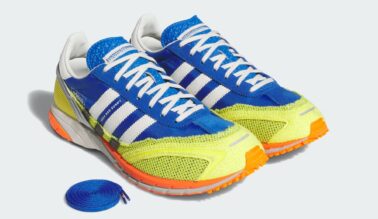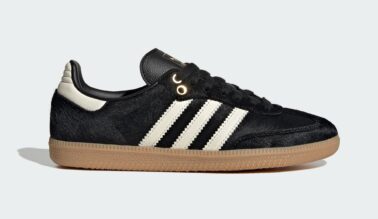This post may contain affiliate links. Please read our disclosure policy.
words, interview & images // Nick DePaula:
In less than five years, the Crazy Light franchise has become a category shifting silhouette, signaling a new direction for the adidas Basketball group with the hopes of re-establishing the brand in the eyes of top players around the country.
After being the first hoops shoe to break the 10-ounce barrier in a size 9 — at a mere 9.8 ounces — the series has progressed steadily in its infancy, with small tweaks and updates made to key components like the SprintWeb upper and SprintFrame chassis. In many ways, the first one was so good, that there wasn’t all that much to change.
Now in 2015, the latest model once again looks to redefine where the category is headed from both a performance and aesthetic lens. Officially dubbed the Crazylight Boost 2015, the newest edition introduces Primeknit to the category, ditching the thinner synthetics of the past for a more flexible and soft fabric upper. There’s also a full helping of heel Boost this time around, a noted improvement over last year’s partially exposed unit. (Though I’d still prefer forefoot Boost over heel, if I had to pick.)
To hear all about the new model, I recently caught up with Robbie Fuller, the Design Director of Advanced Concepts at adidas, who’s shaped the look of each of the five Crazy Light models. He’s currently over in Fuzhou, China at the brand’s factory working away on future sneakers, but made some time to catch up over the phone yesterday to break down the new Crazylight Boost 2015.
Nick DePaula: Initially the brief with the first Crazy Light was about stripping away materials and getting under 10 ounces. How has the brief and approach shifted over the years now that you guys have added technologies to the shoe?
Robbie Fuller: At the beginning, the focus was extreme lightweight and to maximize the lightweight experience. As we continue to innovate and come up with new technologies, we’ve seen that some of them have provided an industry-level lightweight. They might not be the lightest weight, but when combined together with the support and comfort, it ends up being the right recipe. John Wall once said, “It’s not about light weight, it’s about right weight.”
In the latest model, we’ve been able to combine the lightweight and comfort benefits of Primeknit, and pair that with more Boost than you got in the last shoe. It still represents what the Crazy Light franchise is about. We’re using leading technologies and still delivering a lightweight experience, but in this case, we’ve been able to maximize the energy by having Boost in it.
Above: Robbie Fuller’s Crazylight Boost 2015 rendering
NDP: Last year’s model introduced Boost to the series and that was a huge part of it. There were samples that had it fully visible in the heel, and then it ended up having a portion of the midsole wrap up around the heel. What was the process like to get the Boost unit in the heel to be fully visible this time around?
RF: With the 2014, we were really close to being able to have it exposed in the heel. That was the goal, but through testing, we decided for that shoe to introduce it the way that we did it, as more of a cartridge. It was the right way then, and it delivered the cushioning we were hoping for. We knew though that our dream of having it exposed was still where we wanted it to end up, so we took the next year to continue to test and try new ways to steam, engineer and manufacture the Boost so that it would be even stronger and able to stand up to the wear and tear of basketball. I’m real excited, cause that’s what we were able to deliver with the new model.
NDP: I’ve been playing in the new shoe already for awhile, and one of the things I hear a lot is just a very straightforward question of, “Why’d you guys decide to put the Boost in the heel instead of the forefoot?” Is there a difference in incorporating it into the forefoot as an encapsulated unit that makes it too difficult?
RF: There’s two things there. One, is we want to protect the Boost experience. If it can’t feel just like what it feels like to wear an UltraBoost or a Pure Boost, then we don’t want to do that. We did tons of testing, and the way that the Boost technology works, is it expands when you put force on it, and it needs somewhere to expand out. From a lot of the testing that we’ve done, we saw that encapsulated Boost components, the material doesn’t have anywhere to go, and you’re not getting that true Boost experience. Right now, we’ve been able to engineer it onto the heel on this model, so that we’re making sure you’re getting that step-in comfort. When you land, you’re also getting that energy absorption in the heel as you roll and transition into the forefoot.
We know that the forefoot is critical, and you probably spend 70% of the time on your forefoot in basketball. If you have the shoe in hand, the adiPrene+ that we used in the forefoot of this model is actually re-engineered so that it’s softer. We wanted there to be more of a smooth transition between the heel and the forefoot, so that you’re getting the feel of a whole system in the shoe. We do know that as we continue to learn about this technology, it’s so good at providing energy and comfort. You don’t really need flex grooves in a Boost midsole, because it’s already so elastic. We’re going to continue to develop it and deliver what everyone online wants. [laughs]
NDP: Is there a player or player type that you have in mind when you set out to design the shoe? At the time of the first shoe, it was mentioned that high school players was a key focus, just with the name being simple and the keys of light and comfort being understandable.
RF: Based on the reaction, we’re making the right products. I just went on a roadshow through Texas, stopping at different high schools and colleges. When you ask them at the end, “Ok, everyone pick up your favorite shoe…” these were still number one on the list. I think consumers change and tastes change, and styles change for sure too. I always say, “Trends come and go, but winning’s always cool.”
When you put the shoe on, it feels like winning. It feels better than anything comfort wise, and Jeff Teague described it by saying, “It feels game-ready. Right out of the box.” Guys don’t have to play three games to break it in. The Primeknit upper is about precision fit. We’re able to zone it, engineer the structures and engineer the stretch so that it delivers per the moves that each sport and each athlete need. The athlete hasn’t changed, and it’s always about the top 10%, the player that’s pushing it, playing on your toes, getting down the court and making highlights.
NDP: In terms of the Primeknit specifically, I’m curious about how different that is from a design standpoint. The first three models were more of a hot meld synthetic, and now as you started to design with Primeknit in mind, how did that change your approach?
RF: You have to go back to school. [laughs] It’s a completely new process, and it’s a new way even to approach, “What is a shape?” It doesn’t have to be a cut-out part anymore. You can blend from one area to the next area, and the function can blend from one area to the next. When you’re talking about color, is it a blue shoe? Well, it could be seven threads of blue, and then the other seven are seven different colors. It really introduces more micro-color into products. For me, I think the cool thing is having a consistent technology like Primeknit across categories, you can see how each category adapts it for their sport. You’ll see some similar structures, but how we use those structures are in different places and different zones for this shoe, versus how it’s used in a shoe like the UltraBoost.
NDP: The UltraBoost is of course mostly only dealing with forward motion. How did the process go of tuning the knit cables here to be suitable for the forces of basketball?
RF: For basketball, Primeknit is a part of the solution, and we’re able to use a tighter structure in the cutting zone that gives more support and not as much stretch as in the vamp and quarter. For the basketball athlete, the better they are, the bigger and stronger they are. The two other things that work together with it, is the supportive holding structure of the webbing underneath. They’re not thin, they’re wider and they distribute force better. You won’t feel any pressure wrapping around the foot.
On the backside of the knit, there’s a reinforcement layer textile that works with the Primeknit to give it some additional support. What we were able to do, instead of just backing the whole thing, we used different structures on the top side and reinforcements on the backside layer. They all work together, so we were able to leave the vamp and the side panel with areas where there’s complete breathability through the Primeknit. It’s not window treatment. It’s not like, “Oh, it’s knit, but it’s been backed entirely.”
NDP: With this being the first Primeknit shoe for basketball, was there anything from an iconic standpoint that you were hoping to incorporate design wise to have the first model be more impactful?
RF: The shoe is real clean. For the first few shoes, it was about the web, and it was about removing and leaving just the structure of the shoe, which became the icon. In this one, I didn’t want there to be some standout shape, cause that’s almost coming from old processes where you have to cut out a part. On this one, we wanted there to also be a focus on the heel, the Boost and the “Badge of Sport” logo, as we call it.
We moved away from stripes on this model and wanted to focus more on the adidas Performance logo, the “Badge of Sport,” as a new clean look. If you look at a lot of the Training apparel right now, they’ve gone to the same approach and it’s really clean and nice. It’s modern, bold and it helps the shoe to go well with a lot of different outfits.
NDP: That was actually my next question, so thanks for covering that one. [laughs] The first three had such a consistent and bold Three Stripes along the collar. Then the first Boost model last year had the angled forefoot stripes.
RF: Yeah, and the focus was to really be clean through the Primeknit, then bold along the heel. Any time we build a shoe from scratch, we look at multiple directions for the branding. There were some concepts early on where we were looking at stripes on the midfoot, or was there any way to add breathability to the shoe while also having the branding? In the end, we just felt that this was the right way to go, to really focus on the heel logo. It’s well balanced, and the elements are very intuitive. When you get the Mid and you see the collar, you know that that’s a Fit collar and your ankle is going to be protected in that 3D-molded zone for a more secure fit.
NDP: Not only has the branding changed, but the entire silhouette has changed. Now, you guys are launching it as a Low. Is that more of a function of a guy like Wiggins wearing it being a key, or has the game just shifted since the first one?
RF: I really think that modern technologies lead to modern visuals. Because the recipe and the ingredients changed, it created a new outcome. Having conversations with Wiggins and Jeff Teague, and we’ve been able to have a lot more interactions with Dame – everything that they’re about and how they play works itself more into this type of product. Even for myself and the design team, we continue to enjoy progressing design and style and moving it to a new place. As you mentioned, the shoes in the line had a consistency for long enough, and it was time for something that could mark a new generation for adidas Basketball footwear.
NDP: How did the decision to add the strap to the Mid come into play? Was that something you got from player feedback, or something that was just a new direction for it as well?
RF: That was about focusing on fit. Sitting on the same floor as the guys from Football and Baseball, they were doing some really exciting things around fit with TechFit closures. I thought it was the right solution for this shoe. It was modern and clean, and you don’t have to have the lacing go all the way up and worry about lace pressure higher up in the foot. It also worked well with the experience of the low-top. The Low has an overlapping construction, where the tongue is connected on one side and then wraps on the other side.
It’s nice that the Mid and the Low both have a similar experience to how you can provide fit for the shoe. One other insight actually came from Tennis, with one of the latest Barricade models. The insight was they had done so many shoes that had a really strong forefoot control element. What they found was that if you took more time in the heel to really lock the foot down and continue to build support working your way from the heel to the front, that you didn’t have to have a large stopping feature up front.
NDP: The first few models had the wavebone traction pattern design. This one is very straightforward as well. Last year, if there was a big criticism of the shoe, I think a lot of people felt the traction pattern could’ve been better indoors.
RF: The story there, is that I listened. [laughs] I went out on the road and I definitely heard feedback that was mixed. Some teams would tell me that the traction needed to be improved, and others would say that it was great. But I want every team to tell me that the traction’s great.
I went back to the same profile that you saw on the Crazy Light 1, which worked so well, and we went that route so that the connection between the shoe and the court is as good as we can do it. That next level up, you’ve got superior cushioning with Boost, you’ve got great fit with the Primeknit and then in the mid you’ve got the TechFit strap. From top to bottom, it’s the best we do.
NDP: With this being the fifth one, it’s just so easy to look back over the years and see how every brand across basketball has shifted towards lighter products for players of all sizes. What’s it like as the designer to look back on that and notice the impact that the series has had?
RF: It’s definitely great to see something you work on deliver. Whether that’s on-court or off-court, you hope that people can be inspired by it. For me, I look at a lot of the shoes and I see the solutions that all of the people that I work with came up with for each one of them. There’s for sure a lot of credit to go around for how we’ve been able to deliver against that lightweight goal.
As we progress in manufacturing, you’re going to continue to see us find every way possible to take apart a shoe and do it in a way that’s more efficient, lighter, more breathable and yet strong. That’s going to be an area that we continue to focus on and continue to innovate on. Ideally, on the 6, the 7 and the 8th one we’ll continue to deliver the lightweight benefits that athletes are demanding.




